
Twenty years ago a Little group of friends started to live their dreams building houses with organic and artistic shapes. We think that there are unlimited possibilities in architecture so that each house could be a unique creation. We like to pass the borderline between sculpture and architecture and during this process we became a laboratory for new ideas and technics that are not commonly used in construction.
More informationFancy spending a night in a giant sculpture? Las Olas is a magical retreat on a hillside above the shores of Lake Titicaca and Copacabana beach
Bochum. Martin Strätker stammt aus Bochum-Riemke. Am Titicacasee lebt er seinen Traum und hat sogar Umweltprojekte initiiert und umge
Con un estilo claramente gaudiano y basado en el concepto tan de moda “ecolodge”, ocho cabañas diseñadas escrupulosamente y con todo lujo de detalles se alzan en la falda del famoso Montículo desde el que se contempla el lago.
21 years ago, German sculptor Martin Strätker fell in love with a Bolivian woman and decided to settle down in the small town of Copacabana on the shores of Lake Titicaca.
MARTIN STRATKER – COPACABANA, BOLIVIA
Schnecken- und Baumhäuser auf mehr als 3800 Metern: der Deutsche Martin Strätker hat sich am Titicacasee sein Traumhotel gebaut. In dem kleinen bolivianischen Ort nennen sie ihn nur "el loco" - den Verrückten.
Hoch über dem Titicacasee hat Martin Strätker sein Traumreich gebaut, ein Hotel wie aus einem Märchen. Hier erzählt der Tischler und Bildhauer aus Bochum, was er in 26 Jahren Bolivien gelernt hat und wofür eine Heizung gut ist.
Address: Calle Michel Perez (Final), Copacabana - Bolivia
Cell phone: +591 725 08668
E-mail: info@construarte.biz
Website: www.construarte.biz

Copacabana es un pueblo con aproximadamente 5000 habitantes de origen Aymara. Mucho antes de la invasión española, Copacabana era considerada una tierra sagrada por los incas. Las tradiciones y costumbres locales aún se mantienen vivas y al paso de los años el pueblo llegó a ser sede de varios festivales. Para el turismo local, Copacabana es famosa por la iglesia y la imagen de la virgen de Copacabana, considerada la protectora de Bolivia.
Para el turismo internacional, Copacabana es famosa por las maravillosas vistas que se tiene sobre el lago Titicaca. Antes de que los españoles lleguen y cambien el nombre del pueblo a “Copacabana”, la gente local lo llamaba “Kotacawaña”, que significa el mirador sobre el lago.
More informationFor the Cabins “The Eucalypt” and “The Rocks” we used as much local material as we could. All the rocks for the walls sustaining the terraces and for the foundations as well as the soil for the mud bricks are from the same grounds. The eucalyptus trunks that replace the casted concede beams are taken partly from the same piece of land or from within a couple of kilometers. By incorporating areas with plants inside the building and also by leaving huge rocks that were on the ground staying within the cabin as part of the building , we tried to leave behind the separation between inside and outside.

The Cabin “The Turtle” is a 7 meter high dome build from mud brick. It has two floors and it´s main characteristics are the round forms everywhere. On each floor we find a large window and the floors are done with round slices of cypress tree. The beds are round or moon shaped and harmonize perfectly with the building. We inspired ourselves by the houses of the ancient Uru- Chipaya culture from Bolivia and some African tribes who use similar buildings, though smaller and without windows.

The Cabins “The Sky” and “The Waves” offer us wide and open spaces within the circular walls. On the ground floor we find natural stone pillars sostaining the ceiling that flows like a continuous wave. The round polished cypress slices as a floor reflect the circular shapes and the natural rocks of the bathroom floor seem to float. On the top floor the roof is sustained by a tree trunk of some six meters height from which twelve round roof beams descend. It has three big windows in the roof from which we can observe the sky. Similar houses to cabin “The sky” we can find in many ancient cultures. In Bolivia the Uru –Chipaya still uses them as well as some tribes in Africa. In Europe the were used by the Vikings.
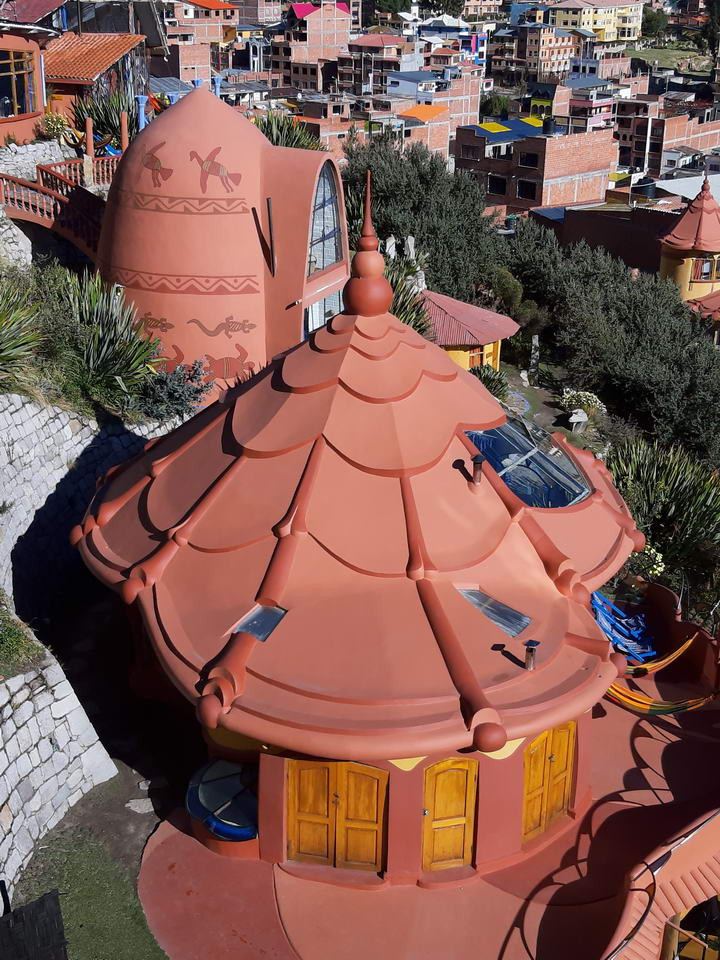
The construction of the Cabin the “Seashell” was a true adventure, build without any plans, none of us knew how high it would be and how the shape would turn out. It is more a sculpture than a house and as such the structure and the finishing evolved bit by bit. It was almost as though it was there before and it was given to us to discover it or to put it into reality.
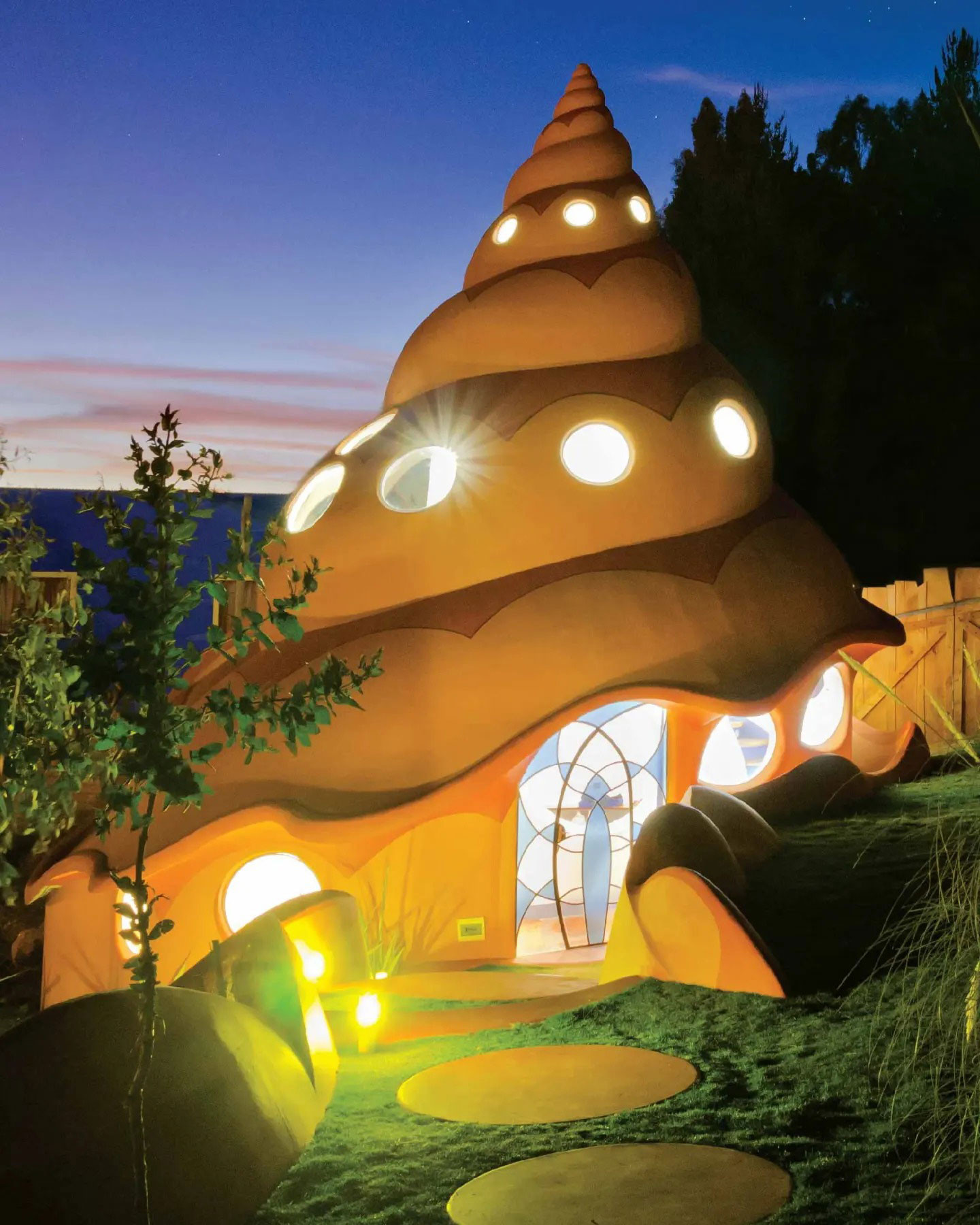
The inspiration for this house is the tepee that the North American Indians have been using for centuries. At moments it felt like something sacred to rediscover shapes that mankind has been using at the beginning of times. Starting with a vague idea, our little team loves the challenge to create something that bit by bit developers in our imagination to soon after materialize in front of our eyes.

The first thing that strikes us about “Los Arcos” is the very spacious ambiance.
Its pillar in the center is like a sculpture that holds the infinite wave of the sealing which flows throughout the space. All the furniture except the kitchen stools are integrated and form part of the same architecture.
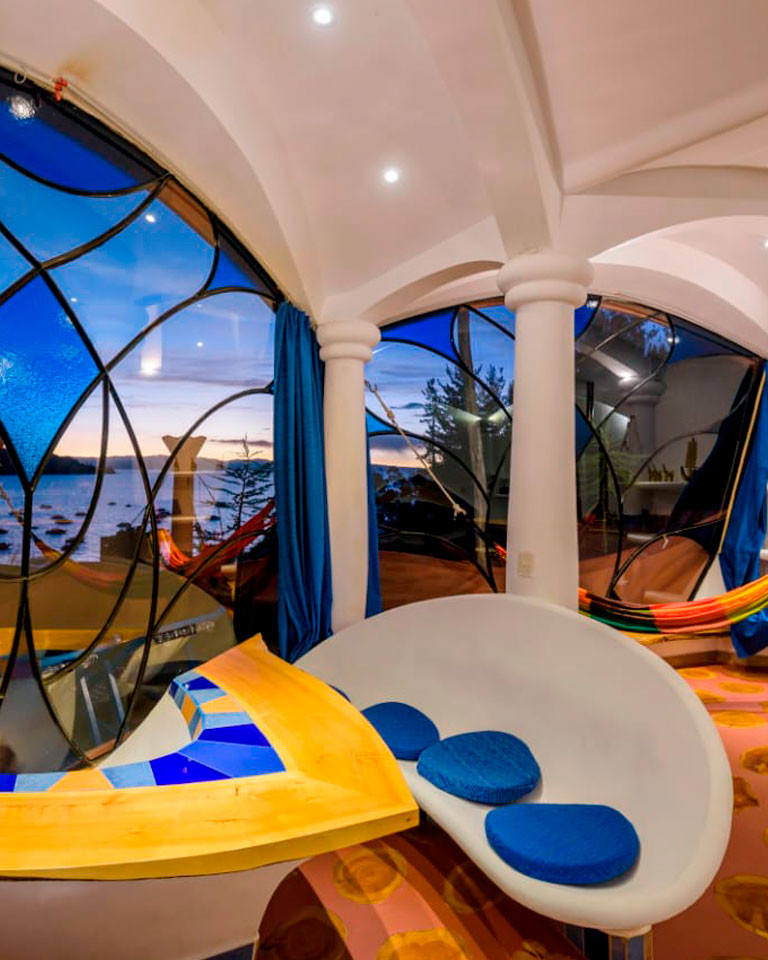
What an adventure in construction! A house in the heights of this beautiful living being! For some time during the elaboration it seemed to us like building temple in the air. As we worked we all felt an enormous release of strength, joy and above all creativity. As never before we explored the theme of the stained glass windows, which seem to tell a whole story. On the lower floor we appreciate animals from the deep waters, recalling the origins of life. From the middle floor we experience an evolution towards land animals and then moving up to the top we see everything that floats and flies, releasing itself into the air.
We were also intrigued by Heraclitus' phrase “Everything flows, nothing remains” and above all we were inspired by the fact that a tree unites the sky with the earth, the sun with the water and that between these forces it continuously transforms matter. We seemed to feel and touch one of the great secrets of life.
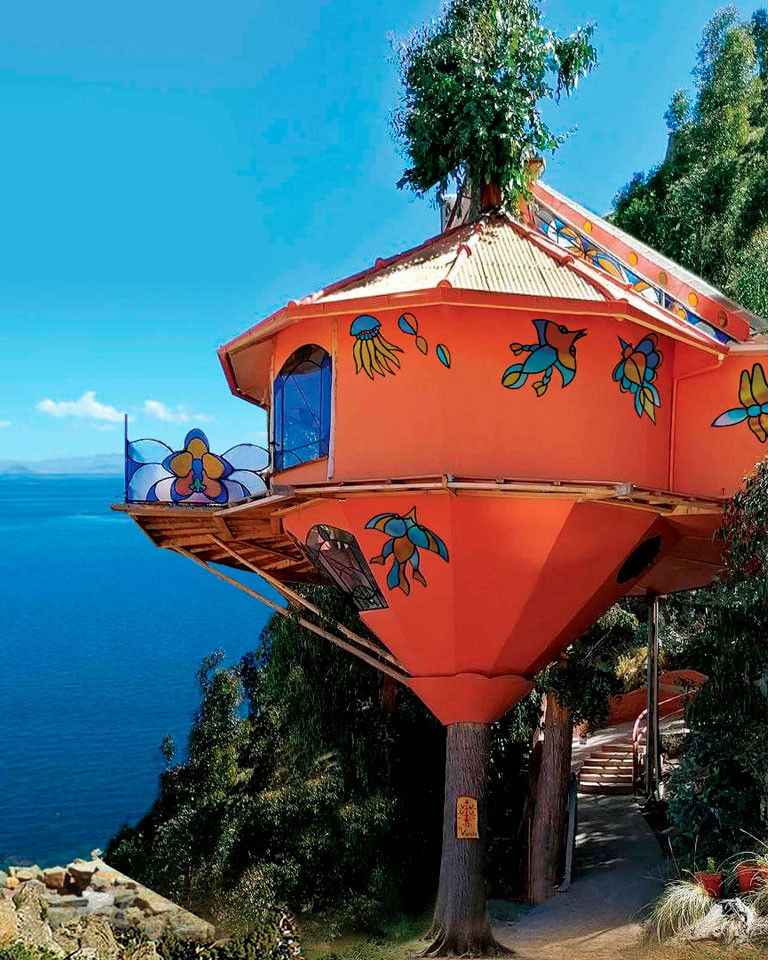
It is exactly what its name expresses. A cabin that seems to be floating above Lake Titicaca. Full of designs and art, an inspiration for everyone who visits it. Again a nice challenge for all of us and at moments we felt like a family making a nest on top of this beautiful tree.
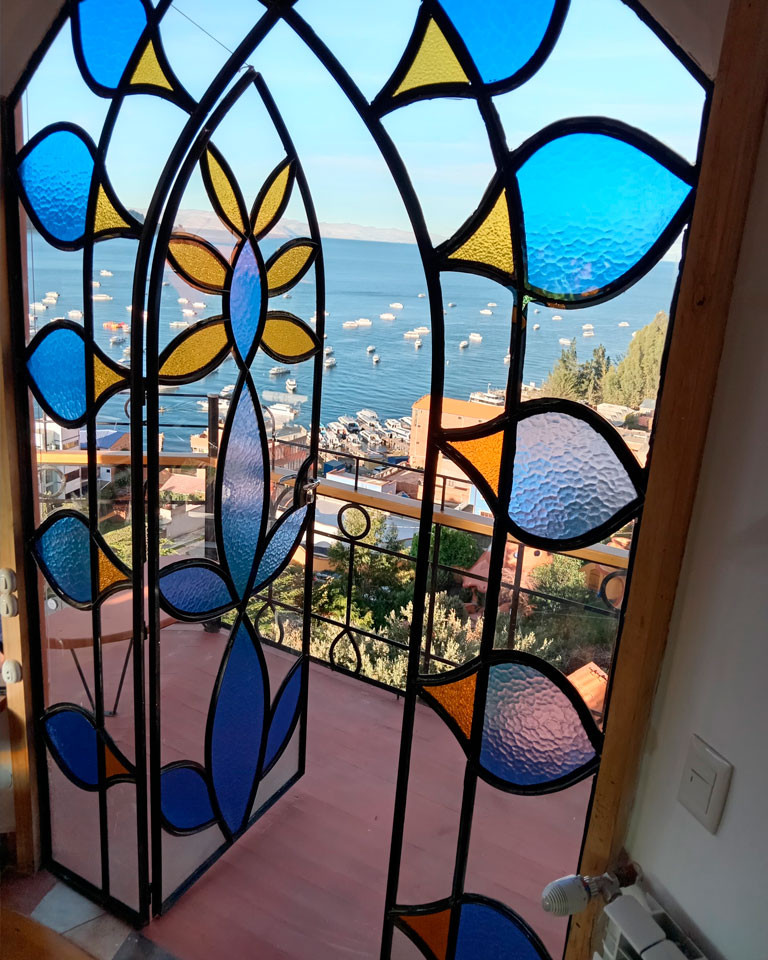
Fancy spending a night in a giant sculpture? Las Olas is a magical retreat on a hillside above the shores of Lake Titicaca and Copacabana beach, with seven suites in their own two-floor buildings shaped like eggs, beehives or fairytale towers, with stained glass windows, circular beds in alcoves, and shell-like spiral staircases – all of which have been created by German sculptor and owner Martin Stratker. Each has its own kitchen and garden with hammocks. One has a bed on a platform reached by a rope ladder, another an indoor water feature. It's an incredibly creative place, with a great cafe too.
• +591 2862 2112, hostallasolas.com. Doubles from £28
Bochum. Martin Strätker stammt aus Bochum-Riemke. Am Titicacasee lebt er seinen Traum und hat sogar Umweltprojekte initiiert und umgesetzt.
Martin Strätkers Blick schweift über den Titicacasee. Vor rund 20 Jahren hat er Copacabana, den Ort auf der bolivianischen Seite des höchstgelegenen schiffbaren Sees, entdeckt. Der 51-Jährige, der in Riemke bei Pflegeeltern aufwuchs, war fasziniert – und kaufte spontan eine Bruchbude für 2000 Dollar. Jahre später entwickelte er daraus ein Hostel mit selbst gebauten Bungalows. Und weil er sich seitdem für die Gemeinde engagiert, ist der Mann aus dem Ruhrgebiet vom Bürgermeister zum „Hijo del sol“ ernannt worden, eine Art Ehrenbürgerwürde der Stadt
Con un estilo claramente gaudiano y basado en el concepto tan de moda “ecolodge”, ocho cabañas diseñadas escrupulosamente y con todo lujo de detalles se alzan en la falda del famoso Montículo desde el que se contempla el lago. “Mi intención era armar una cosa muy diferente a lo que había, con otros colores, más orgánico, con un estilo nuevo y más individual”.
En un trozo de madera desgastado por el tiempo se alcanzan a leer todavía las palabras Centro Cultural. Así empezó en Copacabana lo que hoy son Las Olas, un alojamiento alternativo que constituye un oasis artístico en plena jungla de asfalto, ladrillo y hostales que cada vez se erigen más altos. “Cuando yo llegué hace 20 años el pueblo era totalmente distinto, tenía mucho más encanto: las calles eran angostas y las casitas de un piso o dos de adobe”, explica Martín Stratker, dueño del hostal.
21 years ago, German sculptor Martin Strätker fell in love with a Bolivian woman and decided to settle down in the small town of Copacabana on the shores of Lake Titicaca. Armed with a great imagination, he decided to give form to his own dream: a weird and wonderful dwelling he called Las Olas (The Waves). Featuring sunny terraced gardens, solar water heaters, wood burners crafted from mud, and custom-made furniture in adobe suites, the place looks like it belongs in a fairy tale. And after a recent visit, we decided it feels that way too.
Martin Stratker is a German sculptor and carpenter. For 14 years he has been building ecological houses with organic and artistic forms with a group of friends. All the eco materials that Martin uses come from the place of construction: stone, earth and wood. In recent years he has planted more than 500 trees on Mount Calvario to further reduce the environmental impact of his buildings and to found one of the first places to do sustainable tourism. Copacabana’s Hostal Las Olas is a unique work where the boundary between sculpture and architecture does not exist, where you can feel the link between the earth and the energy of Lake Titicaca. At 4,000 meters the blue of Lake Titicaca contrasts with the warm and natural colors of the houses.
Schnecken- und Baumhäuser auf mehr als 3800 Metern: der Deutsche Martin Strätker hat sich am Titicacasee sein Traumhotel gebaut. In dem kleinen bolivianischen Ort nennen sie ihn nur "el loco" - den Verrückten.
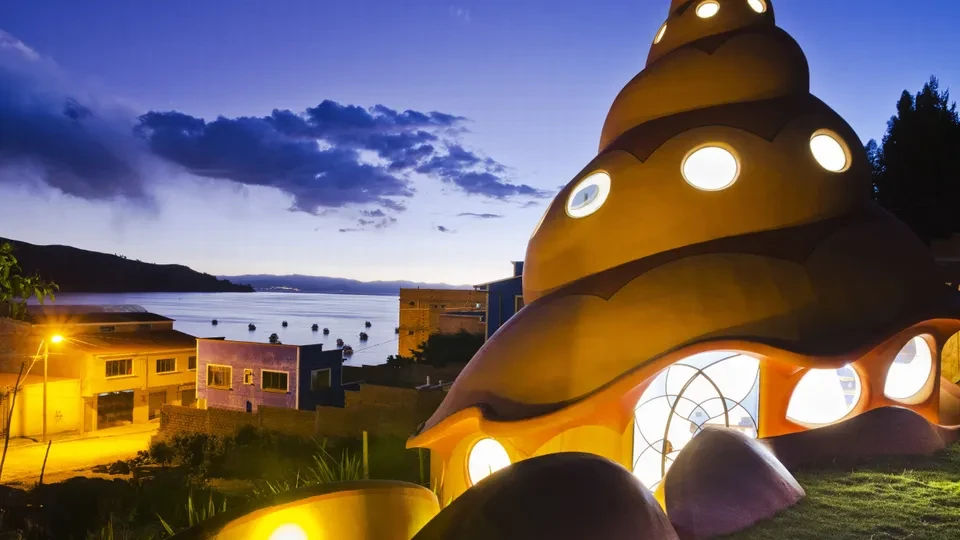 "Las Olas", die Wellen, hat Martin Strätker sein zweites Bauprojekt in Bolivien genannt Foto: Vassil Anastasov
"Las Olas", die Wellen, hat Martin Strätker sein zweites Bauprojekt in Bolivien genannt Foto: Vassil Anastasov